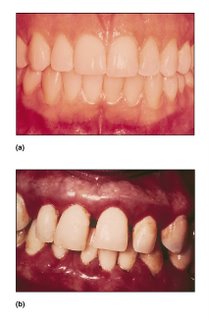
Well...just like other diseases, gum disease also consist of a few types. There are many forms of periodontal disease. The most common ones include the following.
Gingivitis
Gingivitis is the mildest form of periodontal disease. It causes the gums to become red, swollen, and bleed easily. There is usually little or no discomfort at this stage. Gingivitis is reversible with professional treatment and good at home oral care.
Aggressive Periodontitis
A form of periodontitis that occurs in patients who are otherwise clinically healthy. Common features include rapid attachment loss and bone destruction and familial aggregation.
Chronic Periodontitis
A form of periodontal disease resulting in inflammation within the supporting tissues of the teeth, progressive attachment and bone loss and is characterized by pocket formation and/or recession of the gingiva. It is recognized as the most frequently occurring form of periodontitis. It is prevalent in adults, but can occur at any age. Progression of attachment loss usually occurs slowly, but periods of rapid progression can occur.
Periodontitis as a Manifestation of Systemic Diseases
Periodontititis, often with onset at a young age, associated with one of several systemic diseases, such as diabetes.
Necrotizing Periodontal Diseases
An infection characterized by necrosis of gingival tissues, periodontal ligament and alveolar bone. These lesions are most commonly observed in individuals with systemic conditions including, but not limited to, HIV infection, malnutrition and immunosuppression.
Figure on the left shows the differernces between healthy gums (a) and gum with disease (b). So remember..take care your oral hygiene to prevent gum disease!!!
No comments:
Post a Comment